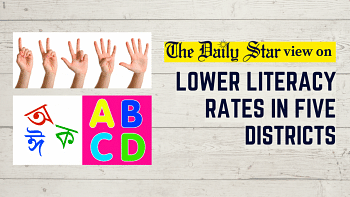Why are so many still functionally illiterate?

It is gravely concerning that around 40 percent of adults in the country are still functionally illiterate, according to the Bangladesh Bureau of Statistic's Literacy Assessment Survey 2023 report. In other words, as the survey shows, only 60.77 percent of people aged 15 years and above are functionally literate. The rate, however, stands at 62.92 for people aged seven years and older. The number of people functionally literate between the ages of 11 and 45 years stands at 73.69 percent, up from 53.70 percent in 2011. And given that the rate of functional literacy among younger age groups is higher, it can be expected that it will continue increasing going forward. Yet, the slow pace of progress and the still absurdly high rate of illiteracy – despite the government's commitment to turn this around – is disappointing.
According to BBS officials, anyone who can read, understand, interpret, communicate, and count verbally and in writing is considered "functionally literate". Hence, for this, the standard for someone to be considered as literate is slightly different from what was used in the Household Income and Expenditure Survey 2022 and the Population and Housing Census 2022 – where the literacy rate was found to be higher. One may argue, however, that the functional literacy rate gives a more complete picture of the nation's state and quality of literacy. In that regard, Bangladesh has evidently a long way to go in terms of enjoying the full benefits of literacy.
Another matter that needs to be looked at closely is the discrepancy in literacy among people of different genders and geographical locations. For example, among young people, it seems boys are falling behind girls in terms of functional literacy. Additionally, there seems to be a big difference in the functional literacy rate between people living in urban areas, at 71.06 percent, and those living in rural areas, at 56.12 percent. Clearly, much more focus needs to be put on providing quality education to individuals residing in rural areas.
The fact that nearly 40 percent of adults in the country are functionally illiterate should also raise questions regarding the overall quality of our education. Why is it that such a large percentage of people failed to pass the BBS' literacy requirement when the percentage of people who have received primary education is higher? This means that despite receiving education, many are failing to achieve functional literacy – which somewhat defeats the very purpose of receiving it. These are questions that deserve greater attention from our policymakers. The government needs to address them as well as find ways to speed up the rate at which functional literacy in the country is increasing.


 For all latest news, follow The Daily Star's Google News channel.
For all latest news, follow The Daily Star's Google News channel. 









Comments